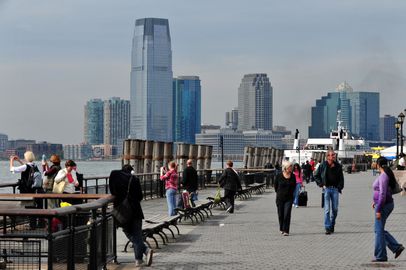

When the Dutch acquired Manhattan in the 17th century, the tip of the island became a military zone, defending the settlement from hostile enemies. When the British took possession of the island they maintained the defensive structures and even lined the waterfront with artillery batteries. After the Americans won the Revolutionary War in 1783, the last British troops were escorted to their ships, which were docked by the Fort Amsterdam. Then General George Washington led the Continental Army from the area known today as Harlem all the way down south to the tip of Manhattan, to the fort. The day, known as Evacuation Day, was the first big celebration in the new independent State of New York.
In the beginning of the 19th century, when Fort Amsterdam had already been taken down and replaced with Castle Clinton, the waterfront was lined with artillery batteries that were ready to open fire on an approaching enemy. The units of heavy guns were reinforced during the War of 1812, in which America fought against Great Britain over issues such as trade restrictions and Britain's support of the Native Indians. However, the English never attacked New York and several years after the end of the war the batteries were dismantled and taken to other defensive points.
The park, which got its name from the batteries that had stood next to the water, was created in the middle of the 19th century by continuous landfills that the city carried out in order to expand the territory. In fact, the original waterfront was located approximately at the level of today's State Street, which connects Broadway on the western side of the island's tip to FDR Drive on the eastern.
Battery Park is an excellent place to promenade on a sunny afternoon and gaze out onto the Upper New York Bay. Today's waterfront face's south and is therefore inundated with bright, often blinding, sunlight. On clear days it is possible to make out Ellis Island, which can be visited on a ferry leaving from the park. Most of the island was also created by landfills that were carried out from the middle of the 19th century to 1934. In 1890 Ellis Island became an immigration station. The stone building that stands there today was erected in 1900, replacing an earlier one built out of wood. By the time it closed in 1954, over 12 million immigrants, mostly from Europe, had been processed on the island. About 10.5 million immigrants continued their migration to other American cities. However, the US authorities did not accept everyone who made the journey across the Atlantic Ocean. Roughly two percent of the people who arrived in New York were sent back either because of their health or their criminal background.
Beyond Ellis Island, it is sometimes possible to see the greatest symbol of America: the Statue of Liberty. It stands on Liberty Island and is doubtless the principal New York destination on the list of a first-time visitor. The 46-meter-high statue was given to America as a gift of the French government in 1886. It was designed by Italian-French sculptor Frederic Auguste Bartholdi.
Points of interest in Battery Park include The Sphere, a metallic sculpture created in 1971 by German sculptor Fritz Koenig that had stood in the World Trade Center and survived the 9/11 collapse of the Twin Towers, receiving only a dent; the New York Korean War Veterans Memorial and East Coast Memorial commemorating the US servicemen who perished in the Western Atlantic during World War 2nd.